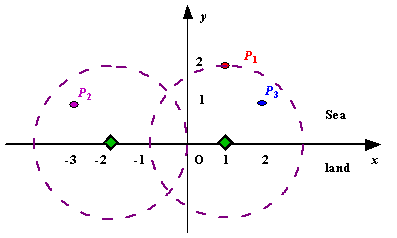POJ 1328
来源:互联网 发布:哈萨维诺亚知乎 编辑:程序博客网 时间:2024/06/14 15:24
Radar Installation
Time Limit: 1000MS Memory Limit: 10000K
Description
Assume the coasting is an infinite straight line. Land is in one side of coasting, sea in the other. Each small island is a point locating in the sea side. And any radar installation, locating on the coasting, can only cover d distance, so an island in the sea can be covered by a radius installation, if the distance between them is at most d.
We use Cartesian coordinate system, defining the coasting is the x-axis. The sea side is above x-axis, and the land side below. Given the position of each island in the sea, and given the distance of the coverage of the radar installation, your task is to write a program to find the minimal number of radar installations to cover all the islands. Note that the position of an island is represented by its x-y coordinates.

Figure A Sample Input of Radar Installations
We use Cartesian coordinate system, defining the coasting is the x-axis. The sea side is above x-axis, and the land side below. Given the position of each island in the sea, and given the distance of the coverage of the radar installation, your task is to write a program to find the minimal number of radar installations to cover all the islands. Note that the position of an island is represented by its x-y coordinates.

Figure A Sample Input of Radar Installations
Input
The input consists of several test cases. The first line of each case contains two integers n (1<=n<=1000) and d, where n is the number of islands in the sea and d is the distance of coverage of the radar installation. This is followed by n lines each containing two integers representing the coordinate of the position of each island. Then a blank line follows to separate the cases.
The input is terminated by a line containing pair of zeros
The input is terminated by a line containing pair of zeros
Output
For each test case output one line consisting of the test case number followed by the minimal number of radar installations needed. "-1" installation means no solution for that case.
Sample Input
3 21 2-3 12 11 20 20 0
Sample Output
Case 1: 2Case 2: 1题意:在x轴的上方是海洋,x的下方是陆地,在海洋中有n个小岛,我们需要雷达来监控小岛,且雷达只能放在x轴上,给定的d就是雷达的覆盖范围,如今给点我们n个小岛的坐标,要我们求出需要覆盖所有的小岛所需的最少雷达数。思路:我们可以以每个点为圆心,然后以d为半径,求出圆与x轴的交点,则有两个点满足条件,可以放置雷达,但我们需要求出最少的雷达数,所以我们需要把每个点求出的那两个可以放置雷达的点按照横坐标从小到大排序,以第一个点设置为雷达起始点,如果该点的下一个点的左端位置要比该点的右端还要大,那么雷达肯定覆盖不到下一个点,那么我们就需要雷达数加1,然后重新设置雷达的位置,如果该点的右边比雷达的右边还要小,那么肯定能够被覆盖,但是因为我们要计算雷达的最小数目,所以我们需要重新设定雷达的位置了,如果所有的情况都不能找到雷达能够覆盖点,那么我们需要输出-1.这是百度的题解:题解:排序完成后,第一个雷达建立在区间的右端,而后一次判断每个区间的左端点,如果在最新建立的雷达右面,那么肯定需要一个雷达,而且也建在区间右端。如果左端点在雷达左面,这个时候要考虑区间的右端在雷达的左面还是右面,如果是右面,那雷达位置就不变,如果在左面,那现在的雷达是覆盖不了的,所以要把雷达放在该区间的右端点!因为这样同时还能覆盖原来的岛,还能覆盖现在的岛。//也许比我解释的更加清楚一些附上详细的代码:#include <iostream>#include <cstring>#include <cstdio>#include <cstdlib>#include <iomanip>#include <algorithm>#include <iomanip>#include <cmath>using namespace std;struct node{ double left,rigth;//我们用来记录每个点求出的雷达点}num[1005];bool cmp(node a,node b){ return a.left<=b.left;//每个雷达点按照横坐标从小到大排序}int main(){ int x,y,n,d,flag,cnt,i,k=1; double p; while(cin>>n>>d) { if(n==0) break; if(d<=0) d=0;//如果半径小于0,肯定是不可能出现的,那么我们就把它设定为0 flag=1; for(i=0;i<n;i++) { cin>>x>>y; if(d*d-y*y<0) { flag=0;//如果该点的纵坐标比半径还大,那么雷达覆盖不到,设定为0 continue; } num[i].left=x-sqrt(d*d-y*y); num[i].rigth=x+sqrt(d*d-y*y); } if(flag)//如果能够找到能够覆盖点的雷达 { sort(num,num+n,cmp); cnt=1; p=num[0].rigth; for(i=1;i<n;i++) { if(num[i].left>p) { p=num[i].rigth;//如果该点的左坐标比雷达的右坐标都大,那么雷达肯定覆盖不到,我们就把雷达数加1,并把该点的右坐标设定为雷达 cnt++; }else if(num[i].rigth<p)//如果该点能够被雷达覆盖,但是我们要求出最少的雷达数,我们需要使雷达尽可能的多覆盖,所以要把雷达的位置缩小 { p=num[i].rigth; } } cout<<"Case "<<k++<<": "<<cnt<<endl; }else{//找不到能够覆盖点的雷达 cout<<"Case "<<k++<<": "<<"-1"<<endl; } //cout<<"Case "<<k++<<": "<<cnt<<endl; } return 0;} 0 0
- poj 1083 & poj 1328
- POJ 1328
- poj 1328
- poj 1328
- POJ 1328
- poj 1328
- POJ 1328
- POJ 1328
- POJ--1328
- poj-1328
- POJ 1328
- POJ 1328
- poj 1328
- poj 1328
- POJ 1328
- POJ 1328
- POJ 1328
- poj 1328
- HDU 5562 Clarke and food(模拟,看起来像背包)
- HDU 2084 数塔
- poj 3694 Network 连通分量+LCA
- sql数据库中“未更新任何行”错误
- Android中的Http通信(一)之Http协议基本知识
- POJ 1328
- GDAL更新至1.8.1后,通过属性查询矢量出错问题的解决方式
- Redis的主从复制
- J2EE笔记三
- Day 8(11.15):自定义函数实训
- 电子商务网站中大数据架构实现个性化的几个关键架构步骤
- 避免SSH连接因超时闲置断开
- eclipse插件link安装方式
- 数据挖掘十大经典算法


